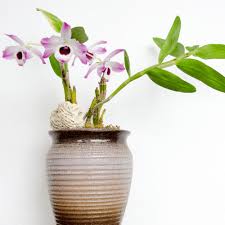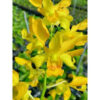Creating the Perfect Ecological Environment for Dendrobium Orchids (Phong Lan Phi Điệp)

Dendrobium orchids, popularly known as Phong Lan Phi Điệp in Vietnam, are a captivating genus renowned for their stunning flowers and diverse species. To cultivate these exquisite plants successfully, understanding and creating the perfect ecological environment is essential. This article will explore the critical components of an ideal habitat for Dendrobium orchids, including light, temperature, humidity, air circulation, potting medium, watering practices, and fertilization. By mastering these factors, orchid enthusiasts can foster a thriving ecosystem that promotes healthy growth and vibrant blooms.
### 1. Understanding Dendrobium Orchids
Dendrobium is one of the largest genera in the Orchidaceae family, with over 1,800 species. These orchids are predominantly found in tropical and subtropical regions of Asia and Australia. They exhibit a range of growth habits, from epiphytic to lithophytic, allowing them to thrive in various environments. Dendrobium orchids are characterized by their elongated pseudobulbs, slender stems, and colorful flowers that can bloom at different times throughout the year.
### 2. Essential Factors for a Thriving Ecological Environment
Creating an ideal habitat for Dendrobium orchids involves several critical factors. Each of these elements plays a crucial role in the overall health and well-being of the plants.
#### 2.1. Light Requirements
Light is one of the most critical factors in orchid cultivation. Dendrobium orchids thrive in bright, indirect light, typically requiring about 2000 to 4000 foot-candles. Here are some tips for managing light exposure:
– **Indoor Cultivation**: Place orchids near east or west-facing windows where they can receive bright, filtered light. If necessary, use sheer curtains to diffuse harsh sunlight.
– **Outdoor Cultivation**: When growing orchids outdoors, provide partial shade, especially during the hottest parts of the day. A location under a tree canopy or a shaded pergola is ideal.
– **Supplemental Lighting**: For indoor growers, consider using grow lights that emit a balanced spectrum of light to supplement natural sunlight, especially during winter months when light availability is reduced.
#### 2.2. Temperature Control
Temperature is another crucial aspect of creating an optimal environment for Dendrobium orchids. These plants generally thrive in a temperature range of 65°F to 80°F (18°C to 27°C) during the day and slightly cooler temperatures at night.
– **Daytime Temperatures**: During the day, temperatures should be warm but not excessive. If indoor temperatures exceed 80°F, consider using fans or air conditioning to maintain a comfortable environment.
– **Nighttime Temperatures**: A drop in temperature at night can stimulate blooming. Nighttime temperatures around 60°F to 65°F (15°C to 18°C) are ideal for most Dendrobium species.
– **Seasonal Adjustments**: Be mindful of seasonal temperature fluctuations. In colder months, ensure that the orchids are not exposed to drafts or extreme cold, which can hinder growth.
#### 2.3. Humidity Levels
Humidity plays a vital role in the health of Dendrobium orchids. These orchids thrive in environments with humidity levels between 40% and 70%. Here are strategies to maintain appropriate humidity:
– **Humidity Trays**: Place shallow trays filled with water and pebbles beneath the pots to increase local humidity. As the water evaporates, it creates a more humid microenvironment.
– **Misting**: Lightly misting the foliage with water can help increase humidity levels, especially during dry seasons. However, avoid excessive misting, as it can lead to fungal issues.
– **Humidifiers**: For indoor growers, using a humidifier can be an effective way to maintain consistent humidity levels, especially in drier climates or during winter.
#### 2.4. Air Circulation
Proper air circulation is essential for the health of Dendrobium orchids. Good airflow helps prevent diseases, reduces humidity buildup, and ensures that the plants receive adequate carbon dioxide for photosynthesis.
– **Fans**: Use small fans to promote air circulation in indoor growing spaces. Position them to create gentle air movement without direct drafts on the plants.
– **Spacing**: When growing multiple orchids, ensure that they are spaced adequately apart to allow for airflow between the plants.
– **Outdoor Placement**: For outdoor cultivation, place orchids in locations that receive natural breezes. Avoid enclosed spaces that can trap heat and humidity.
### 3. Choosing the Right Potting Medium
The choice of potting medium is crucial for the health and growth of Dendrobium orchids. These plants prefer well-draining substrates that mimic their natural habitat. Common potting mediums for Dendrobium orchids include:
– **Bark Mix**: A mix of fir bark, pine bark, and perlite provides excellent drainage and aeration. This medium allows roots to breathe while retaining some moisture.
– **Sphagnum Moss**: Sphagnum moss can be used as a potting medium for younger plants or when rooting cuttings. It retains moisture but must be monitored to prevent overwatering.
– **Coconut Coir**: Coconut coir is an eco-friendly alternative that retains moisture while providing good drainage. It can be blended with bark or perlite for optimal results.
#### 3.1. Pot Selection
Selecting the right pot is equally important. Dendrobium orchids thrive in pots that provide adequate drainage. Consider using:
– **Plastic Pots**: Lightweight and durable, plastic pots with drainage holes are ideal for orchids, as they retain moisture without becoming overly heavy.
– **Clay Pots**: Clay pots provide excellent aeration and moisture retention. However, they can dry out more quickly, requiring more frequent watering.
– **Hanging Baskets**: For epiphytic varieties, hanging baskets allow for better air circulation and can showcase the orchids’ cascading growth habit.
### 4. Watering Practices
Watering is a critical aspect of orchid care and varies depending on environmental conditions. Dendrobium orchids prefer to dry out slightly between watering, as their roots are susceptible to rot.
#### 4.1. Watering Techniques
– **Frequency**: Watering frequency will depend on factors such as temperature, humidity, and the type of potting medium used. In general, water every 1 to 2 weeks, allowing the potting medium to dry out slightly before the next watering.
– **Water Quality**: Use distilled or rainwater for irrigation, as tap water may contain chemicals that can harm orchids. Always allow the water to reach room temperature before applying.
– **Watering Method**: Water thoroughly, allowing water to flow through the drainage holes. Ensure that excess water drains away, as standing water can lead to root rot.
### 5. Fertilization Strategies
Dendrobium orchids require a balanced fertilizer to support healthy growth and flowering. Fertilization is essential during the active growing season (spring and summer) and should be adjusted during dormancy.
#### 5.1. Types of Fertilizers
– **Liquid Fertilizers**: A balanced liquid fertilizer with an NPK ratio of 30-10-10 or 20-20-20 can be diluted to half strength and applied every two weeks during the growing season.
– **Slow-Release Fertilizers**: Granular slow-release fertilizers can be mixed into the potting medium at the beginning of the growing season to provide a steady supply of nutrients.
– **Organic Options**: Organic fertilizers such as fish emulsion or seaweed extracts can be beneficial. They release nutrients gradually and enhance soil health.
#### 5.2. Timing and Application
– **Growing Season**: During the active growth phase, fertilize every two weeks to promote healthy foliage and bloom development.
– **Dormancy**: Reduce fertilization during the dormant period in fall and winter, as the plants require fewer nutrients.
### 6. Pest and Disease Management
Creating a healthy ecological environment for Dendrobium orchids involves not only promoting growth but also protecting the plants from pests and diseases.
#### 6.1. Common Pests
– **Mealybugs**: These pests appear as white cottony masses on the leaves and stems. Treat infestations with insecticidal soap or neem oil.
– **Scale Insects**: Scale insects attach to the plant and can cause leaf drop. Remove them manually or treat with horticultural oil.
– **Spider Mites**: These tiny pests can cause stippling on leaves. Increase humidity and use miticides or insecticidal soap to control their population.
#### 6.2. Disease Prevention
– **Root Rot**: Overwatering is a leading cause of root rot in orchids. Ensure proper drainage and allow the potting medium to dry between waterings.
– **Fungal Infections**: Fungal issues can arise from high humidity and poor air circulation. Improve airflow and consider using fungicides if necessary.
### 7. Seasonal Care
The care for Dendrobium orchids may vary with the seasons. Adjusting environmental conditions and care practices accordingly can enhance growth and flowering.
#### 7.1. Spring and Summer
– **Active Growth Phase**: Increase watering and fertilization during the growing season to support robust growth and blooming.
– **Repotting**: Spring is an ideal time to repot Dendrobium orchids if necessary. Choose a fresh potting medium and a pot that accommodates the plant’s growth.
#### 7.2. Fall and Winter
– **Dormancy Period**: Reduce watering and fertilization during the dormant phase. Allow the plants to rest, which can stimulate future blooming.
– **Temperature Control**: Ensure that orchids are kept in a cooler environment during the night to promote flowering.
### 8. Conclusion
Creating the perfect ecological environment for Dendrobium orchids (Phong Lan Phi Đi
ệp) is a rewarding endeavor that requires attention to detail and an understanding of the plants’ needs. By managing light, temperature, humidity, air circulation, potting medium, watering practices, and fertilization, orchid enthusiasts can cultivate a thriving habitat that promotes healthy growth and stunning blooms. With proper care and dedication, Dendrobium orchids can become a beautiful centerpiece in any home or garden, bringing joy and elegance for years to come.

